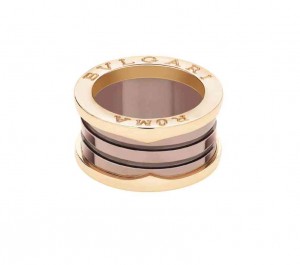
When Sotiro Bulgari opened the first Bulgari boutique in Rome in 1884, he couldn’t have imagined that 130 years later, his name would be synonymous with the world’s most prestigious Italian fine jewelry, which has been worn by Hollywood and high-society icons, from Elizabeth Taylor to Princess Grace of Monaco.
To mark its 130th anniversary, Bulgari is launching special editions of jewelry, watches, accessories and perfumes.
Prominent among these is the new B.zero1 Roma, a tribute to the city that inspired Bulgari over the decades.
Encircled by soft pink gold and four bands of warm bronze ceramic, the B.zero1 collection celebrates not just Bulgari’s founding and its link to the eternal city of Rome but also one of the house’s most iconic pieces.
Launched at the end of 1999, it has a radical, industrial design that fuses two hallmarks of the Bulgari iconography, the Tubogas motif and the distinctive BVLGARI logo.
Over the years, the B.zero1 has had many interpretations. The circular form—symbol of eternal renewal—brings to mind the circular form of the most representative Roman architecture masterpieces, while the Bulgari logo harks back to its debut in 1934, at the opening of the Bulgari flagship store in Rome’s via Condotti.
The B.zero1 Roma’s fluid lines symbolize the imposing circular grandeur of the ancient Colosseum, Castel Sant’Angelo and the Pantheon.
These monuments have marked the passing of time, still inspiring awe. B.zero1 Roma is a contemporary piece of jewelry inspired by the past, while bearing contemporary aesthetic.
Its central looping band is patterned after the golden hoops of the Tubogas’ flexible tubular chain, a late-19th-century design named after the winding tubes of the petrol pump or gas hose that Bulgari reintroduced in the ’40s.
The band is created using a sophisticated technique where long metal strips are wrapped and interlocked without soldering.
While the loops had been used extensively to create serpentine rings, bracelets, necklaces and even watch bands, the B.zero1 marked the first time it is being interpreted in an elemental, minimalist manner.
The second part of the B.zero1 features two flat rings that clamp the sleek central loops, each engraved with the imposing gravitas of the BVLGARI double logo.
The iconic font was introduced in 1934, during the renovation of the flagship via Condotti store in Rome. The Bulgari family decided to adopt the ancient Roman epigraphy, incorporating the Latin “V” instead of the anglicized “U.”
This move links the name far back to the Roman culture, which is the rich, unending source of inspiration for so much of Bulgari’s creative DNA.
The first-generation design was etched in simple yellow or white gold, its industrial vibe moving some fans to dub it “the bolt.”
The resounding success of the B.zero1 collection has inspired Bulgari to innovate more and more, playing with colors and materials. The playful versatility of the B.zero1 has led to new variations, each fresh creation building upon the last.
For instance, the elegant lengths of chains, pendants, bracelets and multilength necklaces of the B.zero1 hang alongside pavé diamonds and colored semiprecious stones.
More recently, outer bands in pink gold have encircled Tubogas bands rendered in white or black ceramic—a delightful tribute to Bulgari’s famed Chandra collection which was launched in 1994. This provocative line was rendered in white porcelain molded into variously shaped beads.
In 2010, the groundbreaking artist and sculptor Anish Kapoor was asked to create a new iteration of the B.zero1 to commemorate the ring’s 10th anniversary. His celebratory piece—a daring fusion of the traditional Tubogas spiral into a gleaming liquid mirror surface—fused contemporary art and Bulgari tradition.
Recent additions to the B.zero1 collection paid homage to Bulgari’s ancient Greek and Roman heritage—the rose-gold caps encircling spirals carved out of marble in three hues, green bowenite, lapis blue and tobacco brown. The use of marble morphs an ancient stone, which has been long associated with enduring luxury and sculptural beauty, into the modernity and industrial lines of the B.zero1. As marble is a natural material, it can vary in color and veining, making each ring different from the other.
One of the most unexpected combinations explored by Bulgari over the years is the one between pink gold and ceramic.
It is appropriate then that the 2014 advertising campaign commemorates the shot in 2000 by the renowned Italian photographer Fabrizio Ferri. Included is the new B.zero1 Roma ring.
It establishes the B.zero1, and now the B.zero1 Roma, as a signature ring for both men and women, and a brand statement of Bulgari’s timeless design.